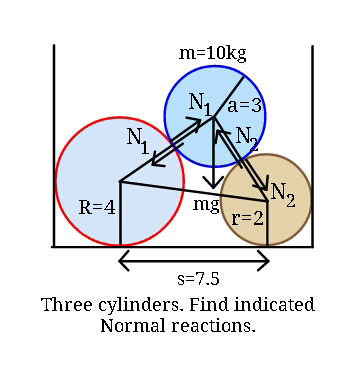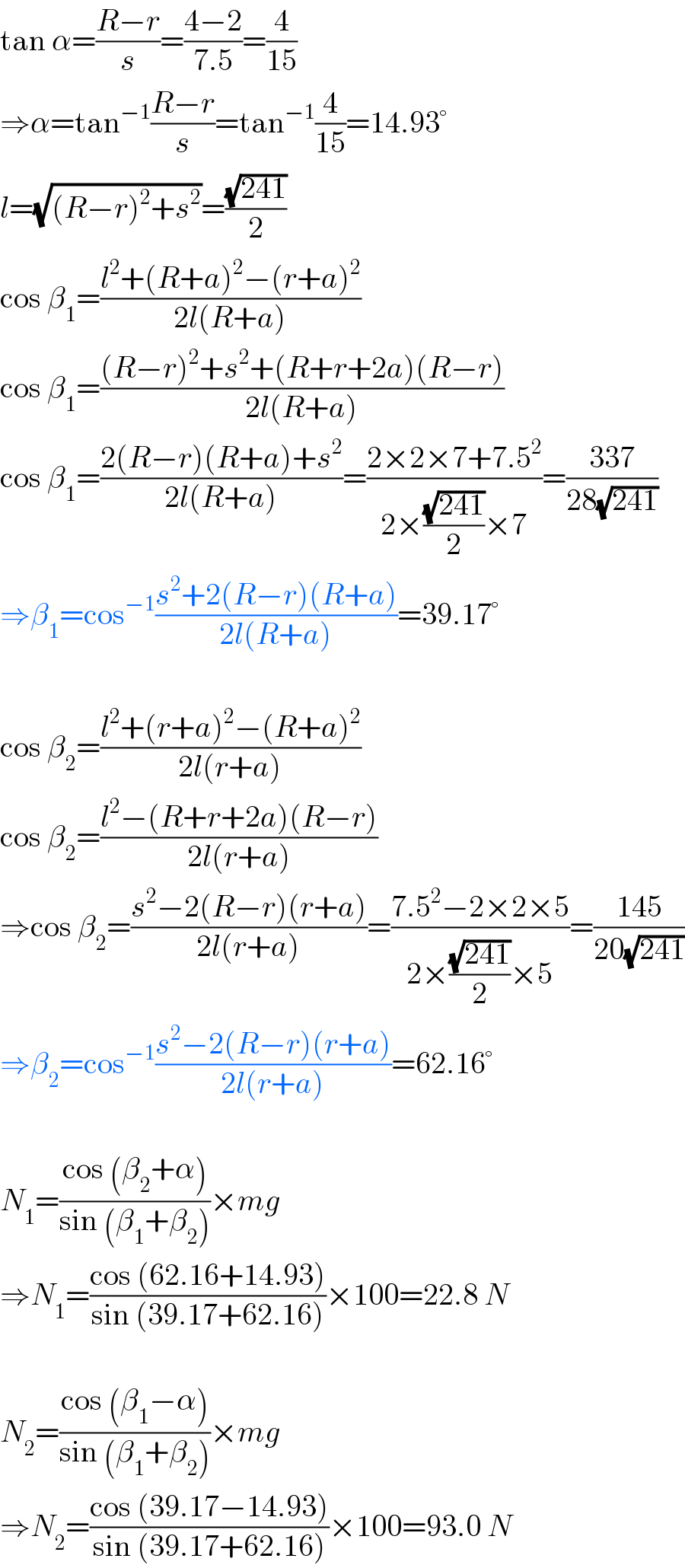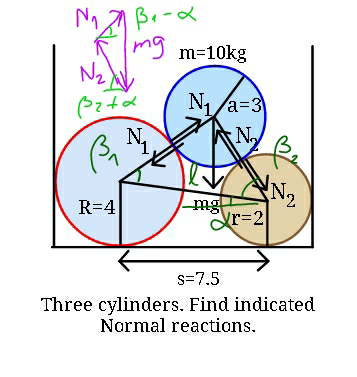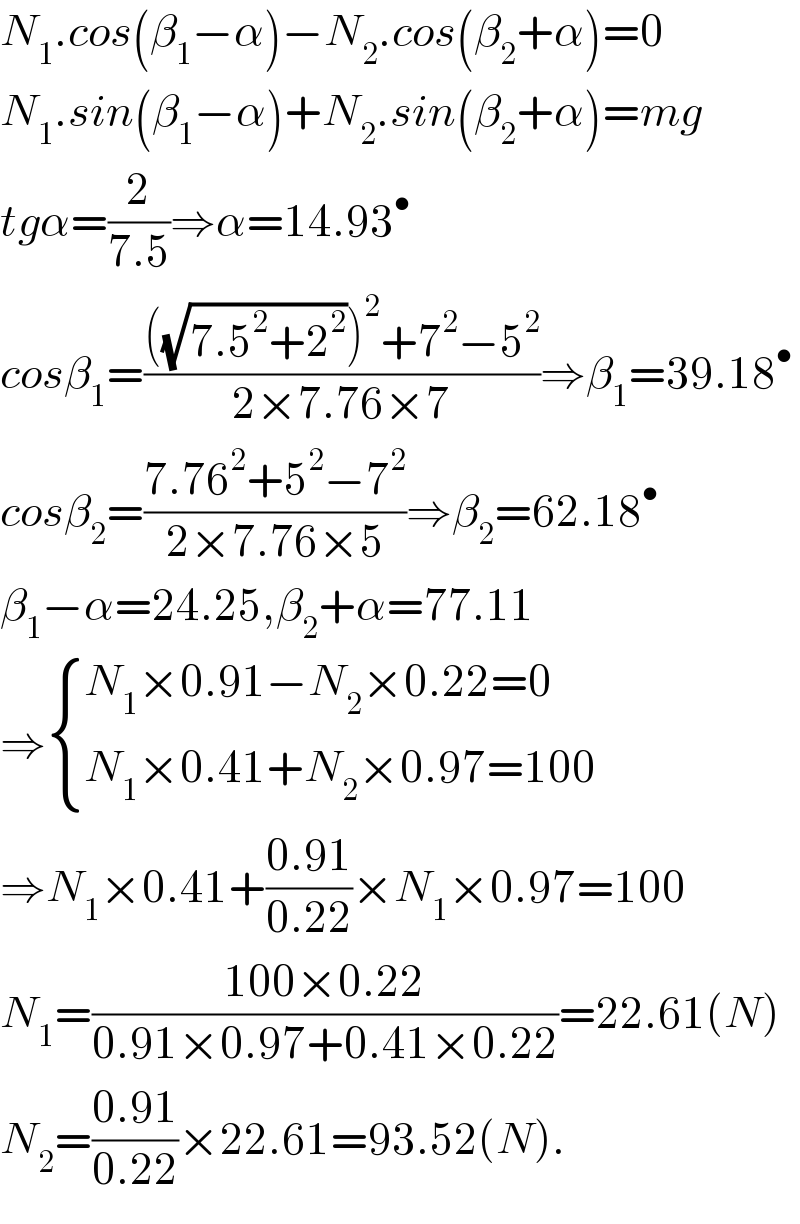Question Number 45673 by ajfour last updated on 15/Oct/18

Commented by ajfour last updated on 15/Oct/18

$${Assuming}\:{no}\:{friction}\:{anywhere}, \\ $$$${find}\:{N}_{\mathrm{1}} ,\:{N}_{\mathrm{2}} \:. \\ $$
Answered by MrW3 last updated on 15/Oct/18

$$\mathrm{tan}\:\alpha=\frac{{R}−{r}}{{s}}=\frac{\mathrm{4}−\mathrm{2}}{\mathrm{7}.\mathrm{5}}=\frac{\mathrm{4}}{\mathrm{15}} \\ $$$$\Rightarrow\alpha=\mathrm{tan}^{−\mathrm{1}} \frac{{R}−{r}}{{s}}=\mathrm{tan}^{−\mathrm{1}} \frac{\mathrm{4}}{\mathrm{15}}=\mathrm{14}.\mathrm{93}° \\ $$$${l}=\sqrt{\left({R}−{r}\right)^{\mathrm{2}} +{s}^{\mathrm{2}} }=\frac{\sqrt{\mathrm{241}}}{\mathrm{2}} \\ $$$$\mathrm{cos}\:\beta_{\mathrm{1}} =\frac{{l}^{\mathrm{2}} +\left({R}+{a}\right)^{\mathrm{2}} −\left({r}+{a}\right)^{\mathrm{2}} }{\mathrm{2}{l}\left({R}+{a}\right)} \\ $$$$\mathrm{cos}\:\beta_{\mathrm{1}} =\frac{\left({R}−{r}\right)^{\mathrm{2}} +{s}^{\mathrm{2}} +\left({R}+{r}+\mathrm{2}{a}\right)\left({R}−{r}\right)}{\mathrm{2}{l}\left({R}+{a}\right)} \\ $$$$\mathrm{cos}\:\beta_{\mathrm{1}} =\frac{\mathrm{2}\left({R}−{r}\right)\left({R}+{a}\right)+{s}^{\mathrm{2}} }{\mathrm{2}{l}\left({R}+{a}\right)}=\frac{\mathrm{2}×\mathrm{2}×\mathrm{7}+\mathrm{7}.\mathrm{5}^{\mathrm{2}} }{\mathrm{2}×\frac{\sqrt{\mathrm{241}}}{\mathrm{2}}×\mathrm{7}}=\frac{\mathrm{337}}{\mathrm{28}\sqrt{\mathrm{241}}} \\ $$$$\Rightarrow\beta_{\mathrm{1}} =\mathrm{cos}^{−\mathrm{1}} \frac{{s}^{\mathrm{2}} +\mathrm{2}\left({R}−{r}\right)\left({R}+{a}\right)}{\mathrm{2}{l}\left({R}+{a}\right)}=\mathrm{39}.\mathrm{17}° \\ $$$$ \\ $$$$\mathrm{cos}\:\beta_{\mathrm{2}} =\frac{{l}^{\mathrm{2}} +\left({r}+{a}\right)^{\mathrm{2}} −\left({R}+{a}\right)^{\mathrm{2}} }{\mathrm{2}{l}\left({r}+{a}\right)} \\ $$$$\mathrm{cos}\:\beta_{\mathrm{2}} =\frac{{l}^{\mathrm{2}} −\left({R}+{r}+\mathrm{2}{a}\right)\left({R}−{r}\right)}{\mathrm{2}{l}\left({r}+{a}\right)} \\ $$$$\Rightarrow\mathrm{cos}\:\beta_{\mathrm{2}} =\frac{{s}^{\mathrm{2}} −\mathrm{2}\left({R}−{r}\right)\left({r}+{a}\right)}{\mathrm{2}{l}\left({r}+{a}\right)}=\frac{\mathrm{7}.\mathrm{5}^{\mathrm{2}} −\mathrm{2}×\mathrm{2}×\mathrm{5}}{\mathrm{2}×\frac{\sqrt{\mathrm{241}}}{\mathrm{2}}×\mathrm{5}}=\frac{\mathrm{145}}{\mathrm{20}\sqrt{\mathrm{241}}} \\ $$$$\Rightarrow\beta_{\mathrm{2}} =\mathrm{cos}^{−\mathrm{1}} \frac{{s}^{\mathrm{2}} −\mathrm{2}\left({R}−{r}\right)\left({r}+{a}\right)}{\mathrm{2}{l}\left({r}+{a}\right)}=\mathrm{62}.\mathrm{16}° \\ $$$$ \\ $$$${N}_{\mathrm{1}} =\frac{\mathrm{cos}\:\left(\beta_{\mathrm{2}} +\alpha\right)}{\mathrm{sin}\:\left(\beta_{\mathrm{1}} +\beta_{\mathrm{2}} \right)}×{mg} \\ $$$$\Rightarrow{N}_{\mathrm{1}} =\frac{\mathrm{cos}\:\left(\mathrm{62}.\mathrm{16}+\mathrm{14}.\mathrm{93}\right)}{\mathrm{sin}\:\left(\mathrm{39}.\mathrm{17}+\mathrm{62}.\mathrm{16}\right)}×\mathrm{100}=\mathrm{22}.\mathrm{8}\:{N} \\ $$$$ \\ $$$${N}_{\mathrm{2}} =\frac{\mathrm{cos}\:\left(\beta_{\mathrm{1}} −\alpha\right)}{\mathrm{sin}\:\left(\beta_{\mathrm{1}} +\beta_{\mathrm{2}} \right)}×{mg} \\ $$$$\Rightarrow{N}_{\mathrm{2}} =\frac{\mathrm{cos}\:\left(\mathrm{39}.\mathrm{17}−\mathrm{14}.\mathrm{93}\right)}{\mathrm{sin}\:\left(\mathrm{39}.\mathrm{17}+\mathrm{62}.\mathrm{16}\right)}×\mathrm{100}=\mathrm{93}.\mathrm{0}\:{N} \\ $$
Commented by MrW3 last updated on 15/Oct/18

Commented by ajfour last updated on 15/Oct/18

$${Yes}\:{Sir},\:{what}\:{to}\:{say},\:{i}\:{am}\:{spellbound}; \\ $$$${excellent}\:{solution},\:{and}\:{no}\:{other} \\ $$$${better}\:{way}\:{out}! \\ $$
Commented by behi83417@gmail.com last updated on 15/Oct/18

$${N}_{\mathrm{1}} .{cos}\left(\beta_{\mathrm{1}} −\alpha\right)−{N}_{\mathrm{2}} .{cos}\left(\beta_{\mathrm{2}} +\alpha\right)=\mathrm{0} \\ $$$${N}_{\mathrm{1}} .{sin}\left(\beta_{\mathrm{1}} −\alpha\right)+{N}_{\mathrm{2}} .{sin}\left(\beta_{\mathrm{2}} +\alpha\right)={mg} \\ $$$${tg}\alpha=\frac{\mathrm{2}}{\mathrm{7}.\mathrm{5}}\Rightarrow\alpha=\mathrm{14}.\mathrm{93}^{\bullet} \\ $$$${cos}\beta_{\mathrm{1}} =\frac{\left(\sqrt{\mathrm{7}.\mathrm{5}^{\mathrm{2}} +\mathrm{2}^{\mathrm{2}} }\right)^{\mathrm{2}} +\mathrm{7}^{\mathrm{2}} −\mathrm{5}^{\mathrm{2}} }{\mathrm{2}×\mathrm{7}.\mathrm{76}×\mathrm{7}}\Rightarrow\beta_{\mathrm{1}} =\mathrm{39}.\mathrm{18}^{\bullet} \\ $$$${cos}\beta_{\mathrm{2}} =\frac{\mathrm{7}.\mathrm{76}^{\mathrm{2}} +\mathrm{5}^{\mathrm{2}} −\mathrm{7}^{\mathrm{2}} }{\mathrm{2}×\mathrm{7}.\mathrm{76}×\mathrm{5}}\Rightarrow\beta_{\mathrm{2}} =\mathrm{62}.\mathrm{18}^{\bullet} \\ $$$$\beta_{\mathrm{1}} −\alpha=\mathrm{24}.\mathrm{25},\beta_{\mathrm{2}} +\alpha=\mathrm{77}.\mathrm{11} \\ $$$$\Rightarrow\begin{cases}{{N}_{\mathrm{1}} ×\mathrm{0}.\mathrm{91}−{N}_{\mathrm{2}} ×\mathrm{0}.\mathrm{22}=\mathrm{0}}\\{{N}_{\mathrm{1}} ×\mathrm{0}.\mathrm{41}+{N}_{\mathrm{2}} ×\mathrm{0}.\mathrm{97}=\mathrm{100}}\end{cases} \\ $$$$\Rightarrow{N}_{\mathrm{1}} ×\mathrm{0}.\mathrm{41}+\frac{\mathrm{0}.\mathrm{91}}{\mathrm{0}.\mathrm{22}}×{N}_{\mathrm{1}} ×\mathrm{0}.\mathrm{97}=\mathrm{100} \\ $$$${N}_{\mathrm{1}} =\frac{\mathrm{100}×\mathrm{0}.\mathrm{22}}{\mathrm{0}.\mathrm{91}×\mathrm{0}.\mathrm{97}+\mathrm{0}.\mathrm{41}×\mathrm{0}.\mathrm{22}}=\mathrm{22}.\mathrm{61}\left({N}\right) \\ $$$${N}_{\mathrm{2}} =\frac{\mathrm{0}.\mathrm{91}}{\mathrm{0}.\mathrm{22}}×\mathrm{22}.\mathrm{61}=\mathrm{93}.\mathrm{52}\left({N}\right). \\ $$
Commented by MrW3 last updated on 15/Oct/18

$${thank}\:{you}\:{sir}! \\ $$
Commented by behi83417@gmail.com last updated on 16/Oct/18

$${thank}\:{you}\:{so}\:{much}\:{dear}\:{master}. \\ $$$${now}\:{it}\:{is}\:{corrected}. \\ $$
